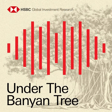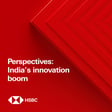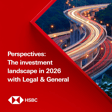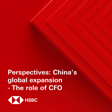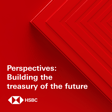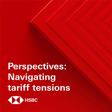Become a Creator today!Start creating today - Share your story with the world!
Start for free
00:00:00
00:00:01

Under the Banyan Tree – India: Tariffs, tax cuts and expensive visa hikes
Pranjul Bhandari, Chief India Economist and Strategist, joins Fred to discuss the outlook for India's economy at a time of higher-than-expected US tariffs, visa changes and domestic reform.
Disclaimer: https://www.research.hsbc.com/R/101/lTWL7T7
Stay connected and access free to view reports and videos from HSBC Global Investment Research, just search for #HSBCResearch on LinkedIn or click here: https://www.gbm.hsbc.com/insights/global-research.
Transcript
Introduction to the Podcast
00:00:01
Speaker
Welcome to HSBC Global Viewpoint, the podcast series that brings together business leaders and industry experts to explore the latest global insights, trends, and opportunities.
00:00:13
Speaker
Make sure you're subscribed to stay up to date with new episodes. Thanks for listening, and now onto today's show.
00:00:24
Speaker
This podcast was recorded for publication on Thursday the 25th of September by HSBC Global Investment Research. Analyst certifications, disclosures and disclaimers must be viewed on the link attached to your media player.
Introducing Hosts and India's Economic Focus
00:00:45
Speaker
Hello from Hong Kong and welcome to Under the Banyan Tree, where we put Asian markets and economics in context. I'm Fred Newman, Chief Asia Economist here at HSBC. We're putting India in the spotlight today with Chief India Economist Pranjal Bhandari, who joins us from Singapore.
Tariff Impacts on India's Economy
00:01:02
Speaker
Terrorists have come in much higher than expected. How much is that hurting the economy and what can counterbalance that hit? Plus, could heavy new fees on U.S. employment visas hurt the Indian economy as the Trump administration builds up barriers to foreign workers?
00:01:16
Speaker
We'll be talking AI, exports, tax cuts, private investment and more. Let's get the conversation started right here under the the Banyan Tree.
00:01:28
Speaker
Well, welcome back to Under the Banyan Tree. Praanjul, it's great to have you. You're obviously our resident expert on the Indian economy as well as Indonesia, but we want to talk about India today. Lots going on. So ah welcome back to the show, Praanjul.
00:01:42
Speaker
Thanks, Fred. It's great to be here.
U.S. Tariffs and India's Economic Sectors
00:01:44
Speaker
So, Pranjal, I wanted to rewind a little bit. um Obviously, what's front and center are the tariffs that are imposed by the U.S. on many economies. And there was sort of a sense early in the year that India might get potentially lower tariffs than other economies, that that might encourage tariffs.
00:02:01
Speaker
Supply chains moving into India, India gaining relative advantage vis-a-vis the other economies. But it turns out that now at the moment we have 50 percent tariffs. That's a headline number imposed by the U.S. on India ah partly for reasons of of India buying Russian oil, for example, partly the reciprocal tariffs.
00:02:24
Speaker
That's a very punchy tariff rate, higher than other economies. How much does that really hurt the Indian economy? How much of a drag is that? Yeah, thanks, Fred. So yes, the 50% tariff is a big number and it did come as a shock to the economy.
00:02:40
Speaker
My sense is that if it stays for a year, it could shave off about 0.7 percentage points from GDP growth, which I think is quite significant. And most importantly, it's going to impact several labor intensive sectors like textiles, gems and jewelry, some agricultural products, ah you know, which won't be good for the jobs outlook in India either. So I would say, yes, it could be quite painful if it lasts for a year.
00:03:05
Speaker
That's interesting because you mentioned jobs and that obviously then has a feed through into consumption, for example, and, you know, ways and potentially on wage growth in India and so forth. So it's it's more than just purely the exports. We should always keep that in mind. But there was something else when it comes to
Impact of U.S. Visa Fees on Indian Workers
00:03:20
Speaker
jobs. And that is that India is an exporter of very talented people.
00:03:25
Speaker
ah software engineers, etc., that often went to Silicon Valley and they benefited from something called an H-1B visa, which is a particular U.S. visa that allows skilled workers to come to the U.S. and and basically have jobs there for a period of three years and it's renewable.
00:03:44
Speaker
But ah recently the announcement was that the U.S. s administration would actually apply $100,000 issuance this visa. And to new issuance of this visa and I think it's over, ah in terms of all these visas being issued, over 70% go to Indian nationals.
00:04:00
Speaker
Is that a big risk for India's economy? Because so many Indians are taking advantage of this visa program in the U.S. and working the U.S. and presumably sending money back to their loved ones in India.
00:04:12
Speaker
Yeah, that's right. You know, it did come as the second shock over the weekend. So first the 50% tariff and now the higher visa fees. But you know, when we do the math, Fred, our senses that if the new ah applicants for this visa don't get a visa or it becomes very expensive for them and they're not able to send money back home,
00:04:32
Speaker
the cost to the economy in terms of you know lower remittances will probably be just about half a billion dollars, which is 0.01% of GDP, which is not very high.
00:04:44
Speaker
So for now, I think this is a cost that is manageable. And of course, there could also be some offsets. For instance, many of the IT companies can start off-toring, getting people to work for their US counterparts, but based out of India.
AI and India's IT Industry
00:04:59
Speaker
You're saying instead of working in Silicon Valley, basically these people would work in Mumbai or Delhi and have the same job, just don't move the countries? Yes, exactly. And then the second thing could be that many of the MNCs in the US could now start putting up their back offices, what we call global capability centers, in India and doing a lot more work from there.
00:05:21
Speaker
in In terms of GDP, it would just basically mean that the money we were now earning because of higher remittances, we earn the same money, but in terms of higher services exports from India. That's interesting. So you're saying actually the the net impact isn't that large. And There's still this trend of actually moving services into into India, and you've done extensive work on these capability centers, which is really multinational companies or MNCs, essentially setting up a lot of their services operations in India. and
00:05:54
Speaker
There was sort of a boom around, I think, 2022, 23 of a lot of this happening. Is this still kind of happening or or have you seen a bit of a quietening down? Because one would think with the labor shortages in the U.S. and Europe that there's still an incentive to move more of these services, jobs to India.
00:06:11
Speaker
Yes, I think it's something that's still continuing and it remains a very important source of growth for the Indian economy. ah Perhaps three years ago it was growing at about 17 to 20% per year and right now it's growing more like 12 to 15% per year.
00:06:25
Speaker
But I think it's still a substantial growth driver for the economy. and important sorts of exports. but But then the big question is always AI. Does the introduction of AI maybe put that at risk, that maybe some of these jobs that are being moved to India could be automated and then suddenly we no longer have the need for big offshore operations? Or could AI actually help that process? Where do you come down in that debate?
00:06:50
Speaker
Yeah, that's a tricky one, Fred. But my sense is that, you know, in in a two to three year horizon, i think these services exposed from India are safe. And I say that because many of the Indian IT companies are actually handholding corporations around the world to become AI ready.
00:07:08
Speaker
And that in itself, you know, is a lot of work. So I think we have that right now. Of course, the question is, when these MNCs become AI ready, then will they need their Indian counterpart anymore or not? And I think maybe that's a question for another day.
00:07:21
Speaker
But I think for now, India has enough. And then, know, there are other work streams that keep coming up, for example, more demand for cloud computing, you know, where India does a lot of work.
00:07:32
Speaker
A lot lot more work on providing support for checks on AI tools. So I think there's a lot of other work that can generate. It's just that the Indian IT sector will have to remain very nimble and keep innovating.
00:07:45
Speaker
Something is done in the past and I hope it continues in the future. I was going to say, yeah, and anything the Indian IT sector has done in recent years is being very nimble. But I wanted to switch to the domestic side because we just established that maybe the service sector outlook remains quite robust but despite some of these issues around visas, for
India's Consumption Outlook
00:08:04
Speaker
example. But there is some drag coming through from the tariffs on manufactured exports. And that puts really the onus on domestic demand to help offset the that drag. um What have you seen lately in terms of consumption investment trends on the domestic side in India?
00:08:19
Speaker
A couple of things are happening on the consumption front, ah which looks positive. One is that, you know, through the from the start of the year, inflation has been falling and real purchasing power has risen, which is great for mass consumption. So we're seeing India's informal sector rise a lot more and consume a lot more than it had last year.
00:08:40
Speaker
So that's sort of been a positive we've had for the last few months. And then we've had this big GST cut. You know, many tax rates have been cut across a large range of goods.
00:08:51
Speaker
And my sense is that over a year, that could add about 0.4 percentage points to India's GDP growth. Now, GST is the goods and services tax that is being levied on consumption goods in in India.
00:09:05
Speaker
That's correct. Yes, that's correct. So this is like a direct boost for consumers. And then, you this comes on the back of another income tax cut that was delivered earlier in the year. So altogether, there are many things coming together. And my sense is that consumption will be strong in the next couple of months and could offset some of the drag from the 50 percent tariff.
00:09:27
Speaker
You mentioned next couple of months. I think that includes the Diwali festival, which is knocking on our door traditionally, obviously always a strong season for consumption. um There is certainly then the question of how sustainable that is beyond that, because tax cuts obviously are one-off boost. um Are you optimistic that we see rising wages and and unemployment sort to carry that consumption momentum forward into next year? Or is the labor market still a bit on the weaker side? Because we've always talked about the fact that there's so many unemployed still in India or underemployed people in the urban sector is not really generating enough jobs. Is that starting to change?
00:10:07
Speaker
I think September and October will be pretty strong because we have these whole GST tax cuts and we also have this Diwali demand, all of that coming together nicely. And we're already seeing demand for cars and consumer durables are rising.
00:10:22
Speaker
So I think for the next two months, things look good. My worry is that once Diwali is behind us and we are looking at November and December and the 50% tariff has not come down as yet, then I think you know we'll start feeling the drag a lot more.
00:10:37
Speaker
ah A couple of things can still be done. My my sense is that the central bank can cut rates ah by about 25 to 50 basis points more, and that could help on the margin. But I think eventually, if we want to regain higher growth, we want to get back jobs, the government will have to do a lot more reforms than it's doing currently.
00:10:56
Speaker
You know, the last month has been good because it announced these GST tax cuts, but it also announced some improvement in the back-end infrastructure, which, you know, i would call a reform. But I think it needs to do a lot more if it wants to safeguard growth over 2026. That's ah that's ah maybe a good a place to take a quick break because um one of the key measures of successful reforms is that private investment begins to increase and ultimately growth is a function of investment. So after a quick break, we're going to come back, Pranjal, and talk about the investment outlook for India.
00:11:41
Speaker
So welcome back everybody. We just talked before the break about some of the challenge and outlook for India on the manufacturing export side, bit brighter on the services export side.
00:11:52
Speaker
Also some hope that consumption in the near term could benefit from tax cuts and some festivals coming through.
Challenges and Reforms in Private Investment
00:11:58
Speaker
But in recent years, one of the key challenges for the Indian economy had been that despite the fact that we had accelerating infrastructure investment,
00:12:08
Speaker
in India, it's quite visible actually. If you go to India, you see new airports, new roads, et cetera. We haven't really seen the private sector start to ramp up investment. And and that's been sort of bit of an Achilles heel, if you will, for for the broader growth picture.
00:12:24
Speaker
But Pranjit, let me put it this to you. Have you seen a bit of a recovery in the private sector's appetite for investment? Or is that still lagging a little bit? Well, look, I like to look at investments in three parts. One is government investment, what we call government capex.
00:12:40
Speaker
I think that has been strong. The second is investment in real estate, housing, commercial apartments. I think all of them have been strong as well. The weak link has been corporate capex, companies setting up new factories. I think that's been the weakest part of India's investment story.
00:12:57
Speaker
And we need that to rise because that's the way to get you know good jobs with a decent wage over the medium term. So, you know, like I get your question, you know, what can India do right to again raise corporate capex?
00:13:09
Speaker
And my sense is a couple of important reforms. And here I would say a few interesting things are already happening. I'm seeing a lot of external reforms happening in India after a very long time.
00:13:21
Speaker
I'm seeing this government being more open to to to signing trade agreements with a bunch of countries from EU to the Middle East, with China being more open to Chinese FDI into the economy.
00:13:33
Speaker
And I'm also seeing the government cutting a lot of import tariffs. Now, remember, India was letting very high import tariffs on many goods that was raising cost of production in the country.
00:13:44
Speaker
So getting that down is also very good for manufacturing in the medium term. so So I would say these external sector reforms look promising. And over time, you know, if India can start seeing FDI coming back, maybe corporate capex could rise.
00:13:57
Speaker
It's interesting. You you frame the the issue of the challenge of weak private sector corporate investment as really a solution to that being external reforms for trade agreements, more foreign direct investment.
00:14:11
Speaker
But at the same time, India is also a very large domestic market. Is there something domestically that maybe is holding back investment? You know, we've talked a lot in the past about restrictive labor loss, for example, or excessive regulation.
00:14:27
Speaker
You know, is the lack of infrastructure still an issue? Is there something obvious on the domestic side that's still missing and the missing piece of the puzzle to get private capex to get to
India's Deregulation and FDI Attraction
00:14:38
Speaker
rebound? Yeah.
00:14:39
Speaker
Yes, absolutely. And that's the second part of reforms I wanted to talk about. There is a big drive of deregulation across the central government and state governments that's going on at this point of time.
00:14:50
Speaker
What this deregulation does is basically it makes it easier to do business in India. uh if india can do this properly and i must say i'm seeing a very comprehensive push this time then perhaps in a two-year horizon it would be easier to produce in india and producing in india can be an attractive prospect because you not only serve export markets from here but you also serve a very large population of india so i think that can be a very nice combination you're doing all of these external reforms But you double them up with all of the deregulation that you're doing domestically. And I think together it can be a big magnet for FDI and for corporate capex.
00:15:30
Speaker
The big question, Fred, would be what does India, what should India produce? I think it's time for India to start producing some mid-tech goods, you know, things like textiles, footwear, furniture, toys.
00:15:42
Speaker
These are more labor intensive. ah After Trump won, we saw a lot of FDI in mid-tech flow around the world, but India wasn't a beneficiary of this. I think if it can get some of these reforms done, it can start attracting some of this mid-tech FDI, which will be good for its jobs as well.
00:16:00
Speaker
Yeah, was going to say, and that obviously links then back to this issue of labor-intensive production, more hiring, higher wages, and ultimately starts that development process that we saw many other Asian economies so successfully. So, Pranjul, it's an encouraging outlook that you're paying for India. um Maybe also the external challenges at the moment, bit of a catalyst for reform. Maybe that's the So the optimist in me, we're looking at the in Indian economy. But yes, generally resilient despite these these challenges and and hopefully more growth to come. I'm sure we're going to check in with you very soon and just to see how the story evolves. So thank you for joining us on the Banyan Tree, Pranjul.
00:16:41
Speaker
Great to be on your show, Fred. See you soon. Well, folks, we're going to have to leave it here. Thanks very much for joining us. From all of us here in Asia, take care and we'll see you again next week.
00:17:13
Speaker
Thank you for joining us at HSBC Global Viewpoint. We hope you enjoyed the discussion. Make sure you're subscribed to stay up to date with new episodes.

